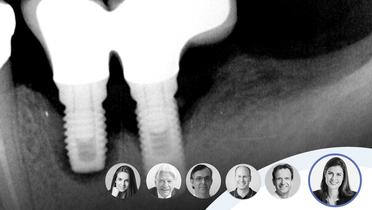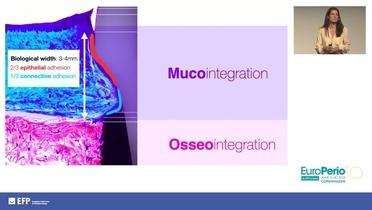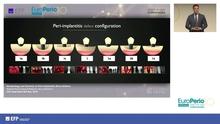Prognostic tool: Prediction of 1 year outcome after peri-implant disease
Rational for a prognostic model for peri-implant pathology
The rationale for developing and using this prognostic model is related to the relative unpredictability of the outcome once an implant is diagnosed with peri-implant disease. This is illustrated by the fact that in most situations, it is not possible to stop peri-implant disease progression, with values of disease re-incidence or implant failure as high as 50%. Prognosis consists in a risk estimation for a future outcome in patients, based on their characteristics.
As a background, prognostic factors are studied in subjects already affected by a disease (not in healthy conditions) and represent an important tool that is already in use in other areas of Medicine to increase the predictability of the outcome. These prognostic factors enable the discrimination between groups of patients with different average prognosis and provide both information and improvement to the basic prognosis, being used to estimate the likely progression of a patient’s disease. In implant dentistry, prognostic factors should be studied in implants that already have peri-implant disease (not healthy implants). We decided to create the prognostic model for peri-implant disease, given that no prognostic model existed.
This prognostic tool was developed by a research group led by Professor Miguel de Araújo Nobre and validated in 2019 [1]. It is intended to:
• Provide clinicians a one year ahead probability of favorable or unfavorable prognosis for implants diagnosed with peri-implant disease based on simple factors that can be collected at any clinical appointment. Favorable prognosis includes remission of the disease with no signs of active peri-implant disease. Unfavorable prognosis is considered when the implant remains with signs of active peri-implant disease, or requires implant removal.
• Provide patients with a graphical information on outcome expectations and education for better self-care decisions.
Introduction to the Prognostic Tool by Miguel Nobre
Prognosis of your patient with an implant diagnosed with peri-implant disease
It is recommended that the clinician should perform regular clinical and radiographical assessments to the patient in order to evaluate peri-implant health, given early diagnosis is paramount to increase the probability of a good prognosis. This tool is intended to be provide prognosis of implants diagnosed with peri-implant disease. If your patient does not have peri-implant pathology and you wish to schedule maintenance, the following assessment too will help you do so: https://www.for.org/en/treat/peri-implant-pathology-risk-assessment/take
To form a prognosis of your patient with peri-implant disease, the prognostic tool may be used: link. Peri-implant disease was defined as the presence of peri-implant pockets ≥5 mm, bleeding on probing and/or suppuration, with concurrent presence of marginal bone loss or clinical attachment loss ≥2 mm comparatively to the previous examination [2]. After performing the prognostic model, the result will stand as a probability estimation of the expected prognosis for that implant.
The limitations of the tool rely on the short follow-up time providing an insight of the prognosis. It was validated in a patient population treated with and is therefore intended to be used in patients with Nobel Biocare implants. The tool should not be used to evaluate implants whose marginal bone level extends to the apical third, as in these cases it already represents a failed implant.
The tool should not be used for deciding to keep or extract the implant. Further skills that are needed by the clinician include solid knowledge of peri-implant pathology’s epidemiology, non-surgical treatment and surgical treatment options, and maintenance.
Clinical relevance
This allows to provide the clinician with a tool to help the decision-making process when attempting to discriminate between good or poor prognosis. However, it should not be used as a justification neither to attempt to save nor to extract the implant, considering the prognostic model is an estimation that provides a probability (not certainty) of an outcome to occur and does not replace the clinician’s judgement. We hope that you find this tool useful in your practice and that you can enhance the overall predictability of your implant treatments, increasing the probability of success in the long term.
How the prognostic tool was developed
To reach the final prognostic model we evaluated 30 variables usually related with peri-implant disease in 240 patients through an epidemiological approach and using multivariable statistics. Finally, the prognostic model was created based on five core variables that aggregated the largest amount of prognostic information and are easily collected in any clinical appointment: the patient’s age, history of periodontitis, early disease development (< 4 years of follow-up after implant insertion) disease severity (with the marginal bone level located on the implants’ middle third), and implant length (>13 mm). This prognostic model enabled a good discrimination between implants with favorable prognosis and implants with unfavorable prognosis concerning the outcome of peri-implant disease, correctly estimating over 70% of the cases that were tested. The next step involved transforming complex mathematical calculations in a model that could easily be used by clinicians in their daily clinical practice.
References:
de Araújo Nobre M, Salvado F, Nogueira P, Rocha E, Ilg P, Maló P. A Prognostic Model for the Outcome of Nobel Biocare Dental Implants with Peri-Implant Disease after One Year. J Clin Med 2019, 8, 1352; doi:10.3390/jcm8091352.
Sanz, M.; Chapple, I.L.; Working Group 4 of the VIII European Workshop on Periodontology. Clinical research on peri-implant diseases: Consensus report of Working Group 4. J. Clin. Periodontol. 2012, 39, S202–S206.
References for the individual prognostic factors:
Age
De Araújo Nobre, M.; Maló, P. Prevalence of periodontitis, dental caries, and peri-implant pathology and their relation with systemic status and smoking habits: Results of an open-cohort study with 22009 patients in a private rehabilitation center. J. Dent. 2017, 67, 36–42.
Renvert, S.; Aghazadeh, A.; Hallström, H.; Persson, G.R. Factors related to peri-implantitis—A retrospective study. Clin. Oral Implants Res. 2014, 25, 522–529.
History of Periodontitis
De Araújo Nobre, M.; Mano Azul, A.; Rocha, E.; Maló, P. Risk factors of peri-implant pathology. Eur. J. Oral Sci. 2015, 123, 131–139.
Lagervall, M.; Jansson, L.E. Treatment outcome in patients with peri-implantitis in a periodontal clinic: A retrospective study. J. Periodontol. 2013, 84, 1365–1373.
Hultin, M.; Gustafsson, A.; Hallstrom, H.; Johansson, L.A.; Ekfeldt, A.; Klinge, B. Microbiological findings and host response in patients with periimplantitis. Clin. Oral Implants Res. 2002, 13, 349–358.
Severe disease (Bone level on the implants' middle third):
De Waal, Y.C.; Raghoebar, G.M.; Meijer, H.J.; Winkel, E.G.; van Winkelhoff, A.J. Prognostic indicators for surgical peri-implantitis treatment. Clin. Oral Implants Res. 2016, 27, 1485–1491.
Lagervall, M.; Jansson, L.E. Treatment outcome in patients with peri-implantitis in a periodontal clinic: A retrospective study. J. Periodontol. 2013, 84, 1365–1373.
Early disease development (< 4 years of follow-up):
Charalampakis, G.; Rabe, P.; Leonhardt, A.; Dahlén, G. A follow-up study of peri-implantitis cases after treatment. J. Clin. Periodontol. 2011, 38, 864–871.
Implant length >13 mm:
De Waal, Y.C.; Raghoebar, G.M.; Meijer, H.J.; Winkel, E.G.; van Winkelhoff, A.J. Prognostic indicators for surgical peri-implantitis treatment. Clin. Oral Implants Res. 2016, 27, 1485–1491.
Lagervall, M.; Jansson, L.E. Treatment outcome in patients with peri-implantitis in a periodontal clinic: A retrospective study. J. Periodontol. 2013, 84, 1365–1373.








